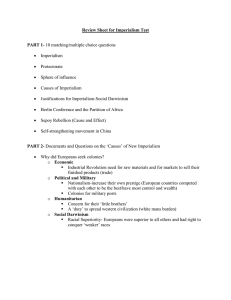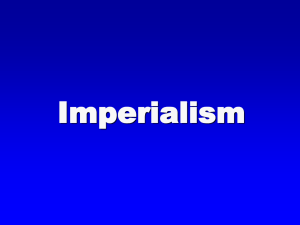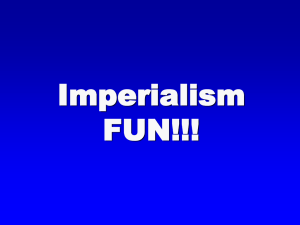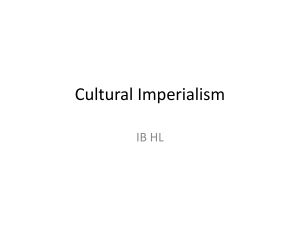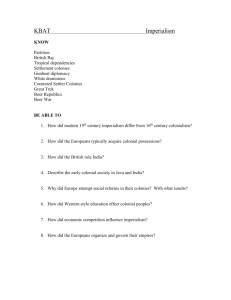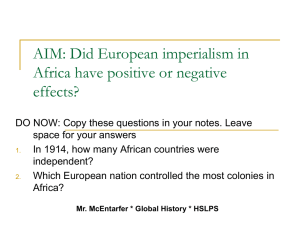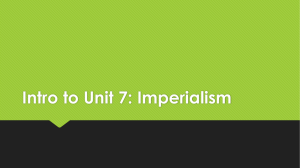Imperialism
advertisement
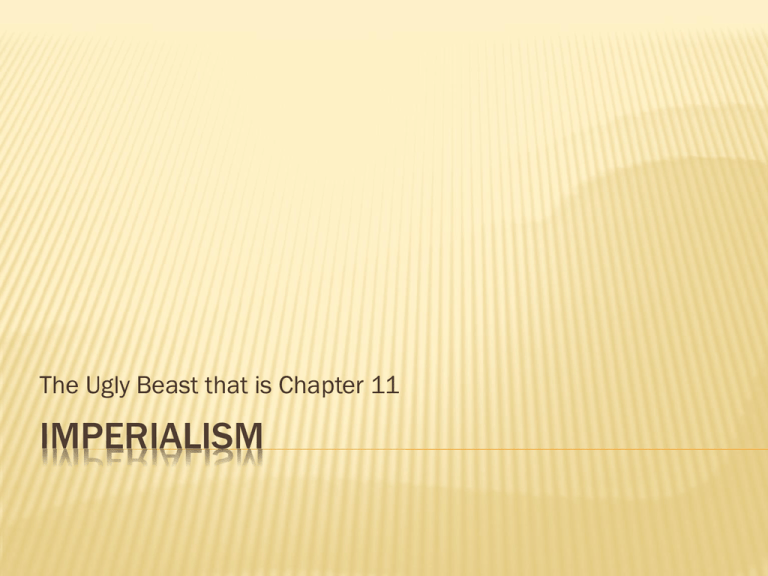
The Ugly Beast that is Chapter 11 IMPERIALISM SECTION 1-BUILDING OVERSEAS EMPIRES SECTION 1 OBJECTIVES Analyze the causes of the “new imperialism.” Explain why Western imperialism spread so rapidly. Describe how imperial governments ruled their empires. FOCUS QUESTION At the end of this section, you will use your notes to answer the following question in at least a paragraph: How did Western nations come to dominate much of the world in the late 1800’s? THE INDUSTRIAL REVOLUTION AS A STARTING POINT Like Great Britain, other Western countries built overseas empires in the late 1800s. The Industrial Revolution had transformed the West. Advances in science and technology, industry, transportation, and communication provided Western nations with many advantages. Armed with new economic and political power, Western nations set out to dominate the world. WHAT IS IMPERIALISM? Imperialism is the domination by one country of the political, economic, or cultural life of another country or region. European states won empires in the Americas after 1492, established colonies in South Asia, and gained toeholds on the coasts of Africa and China. Despite these gains, between 1500 and 1800, Europe had little influence on the lives of the peoples of China, India, or Africa. EUROPE GROWS IN THE 1800’S By the 1800s Europe had gained considerable power. Strong, centrally governed nation-states had emerged, the Industrial Revolution had greatly enriched European economies. Encouraged by their new economic and military strength, Europeans embarked on a path of aggressive expansion that today’s historians call the “new imperialism.” In just a few decades, beginning in the 1870s, Europeans brought much of the world under their influence and control. Like other key developments in world history, the new imperialism exploded out of a combination of causes. IMPERIALISM-ECONOMIC MOTIVES The Industrial Revolution created needs and desires that spurred overseas expansion: Manufacturers wanted access to natural resources such as rubber, petroleum, manganese for steel, and palm oil for machinery. They also hoped for new markets of consumers to whom they could sell their factory goods. Bankers sought ventures to invest their profits. In addition, colonies offered a valuable outlet for Europe’s growing population. IMPERIALISM—POLITICAL AND MILITARY MOTIVES Political and military issues were closely linked to economic motives. Steam-powered merchant ships and naval vessels needed bases around the world to take on coal and supplies. Industrial powers seized islands or harbors to satisfy these needs. Western leaders claimed that colonies were needed for national security. They also felt that ruling a global empire increased a nation’s prestige around the world. the power to impress or influence because of success or wealth IMPERIALISM—RELIGIOUS GOALS Many Westerners felt a genuine concern for their “little brothers” beyond the seas. Missionaries, doctors, and colonial officials believed they had a duty to spread what they saw as the blessings of Western civilization, including its medicine, law, and Christian religion. APPLYING SOCIAL DARWINISM TO IMPERIALISM Behind the idea of the West’s civilizing mission was a growing sense of racial superiority. Many Westerners had embraced the ideas of Social Darwinism. They applied Darwin’s ideas about natural selection and survival of the fittest to human societies. European races, they argued, were superior to all others, and imperial domination of weaker races was simply nature’s way of improving the human species. As a result, millions of non-Westerners were robbed of their cultural heritage. HOW THE WEST COULD DOMINATE TECHNOLOGICAL ADVANTAGES European powers had the advantages of strong economies, well-organized governments, and powerful armies and navies. Superior technology, including riverboats and the telegraph, as well as improved medical knowledge also played a role. Quinine and other new medicines helped Europeans survive deadly tropical diseases. Advances such as Maxim machine guns, repeating rifles, and steam-driven warships were very strong arguments in persuading Africans and Asians to accept Western control. THE NATIVES FIGHT BACK Africans and Asians strongly resisted Western expansion into their lands. Some people fought the invaders, even though they had no weapons to equal the Maxim gun. Ruling groups in certain areas tried to strengthen their societies against outsiders by reforming their own Muslim, Hindu, or Confucian traditions. Finally, many Western-educated Africans and Asians organized nationalist movements to expel the imperialists from their lands. THREE KINDS OF RULE Over the next three slides we will explore three kinds of imperial rule. Colonies Protectorates Spheres of Influence TYPES OF IMPERIAL RULE--COLONIES The leading imperial powers developed several kinds of colonial rule. The French practiced direct rule, sending officials and soldiers from France to administer their colonies. Their goal was to impose French culture on their colonies and turn them into French provinces. The British, by contrast, relied on a system of indirect rule. To govern their colonies, they used sultans, chiefs, or other local rulers. They then encouraged the children of the local ruling class to get an education in Britain. In that way, they groomed a new “Westernized” generation of leaders to continue indirect imperial rule and to spread British civilization. Like France and other imperialist nations, however, Britain could still resort to military force if its control over a colony was threatened. TYPES OF IMPERIAL RULE--PROTECTORATES In a protectorate, local rulers were left in place but were expected to follow the advice of European advisors on issues such as trade or missionary activity. A protectorate cost less to run than a colony did, and usually did not require a large commitment of military forces. TYPES OF IMPERIAL RULE—SPHERE OF INFLUENCE A third form of Western control was the sphere of influence, an area in which an outside power claimed exclusive investment or trading privileges. Europeans carved out these spheres in China and elsewhere to prevent conflicts among themselves. SUMMARY ACTIVITY Today we are going to complete yet another summarization activity: Grab An the following items: 11 x 17 Sheet of Paper A Cube Template Markers/Colored Pencils SUMMARY CUBES Step 1-Enlarge the template on to your 11 X 17 Sheet of paper. Step 2: Cut your cube out of your paper. On the 6 parts of your cube, you are going to complete 6 Tasks. YOUR 6 SIDES Side 1: Your Name and the word Imperialism. (Aim for a Concrete Spelling). Side 2: Define imperialism Side 3: List Economic motives for Imperialism Side 4: List Political Motives for Imperialism Side 5: Compare and Contrast the 3 types of colonial Control Side 6: Create a picture that you believe helps summarize the section the best.

